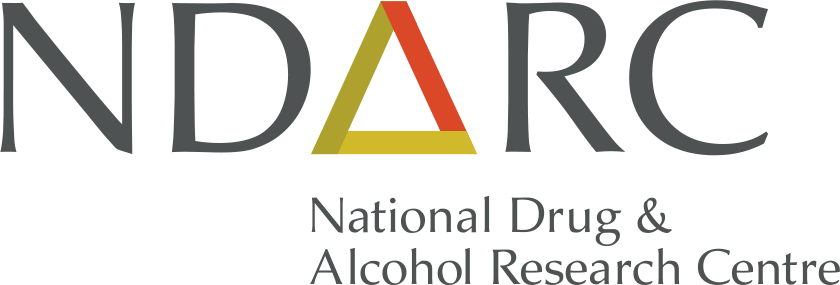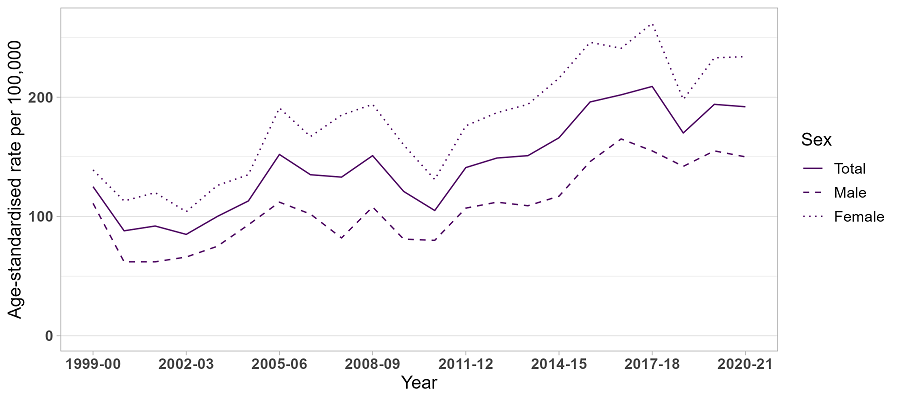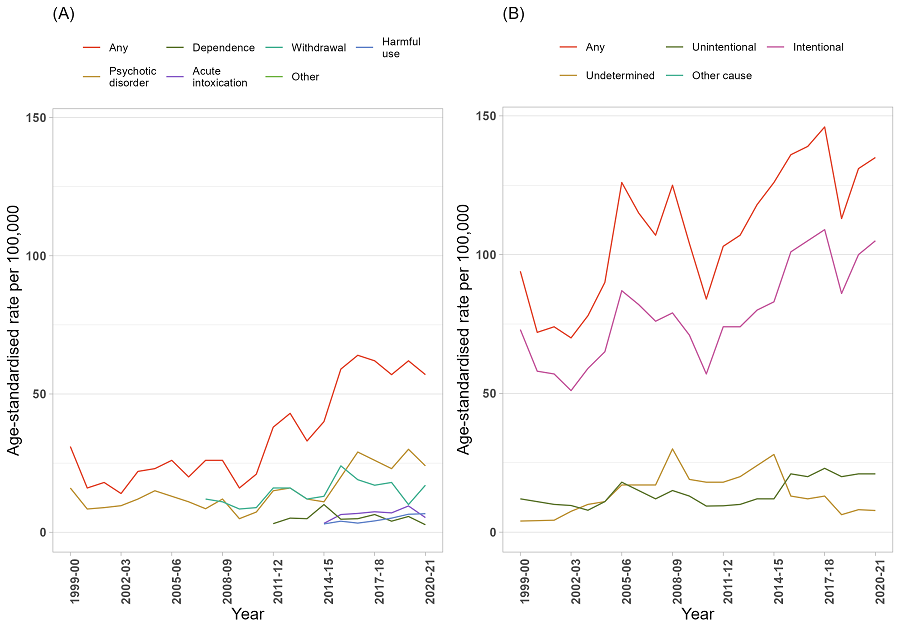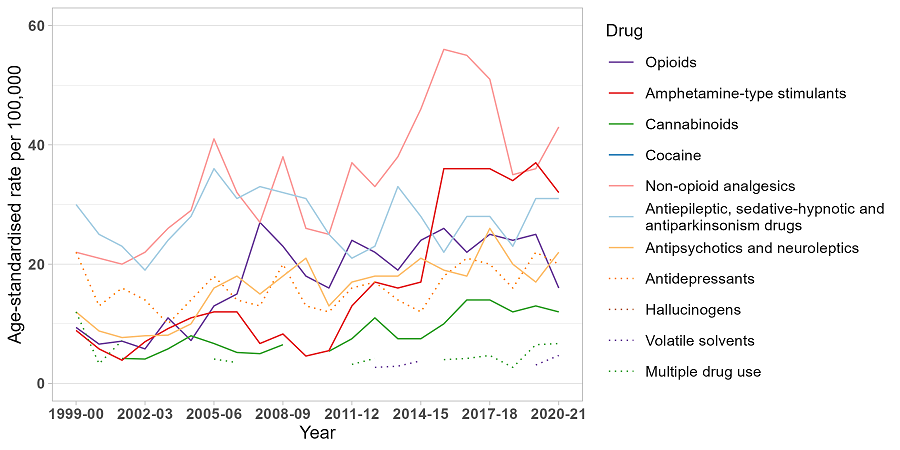Agata Chrzanowska, Nicola Man, Jane Akhurst, Rachel Sutherland, Louisa Degenhardt, Amy Peacock
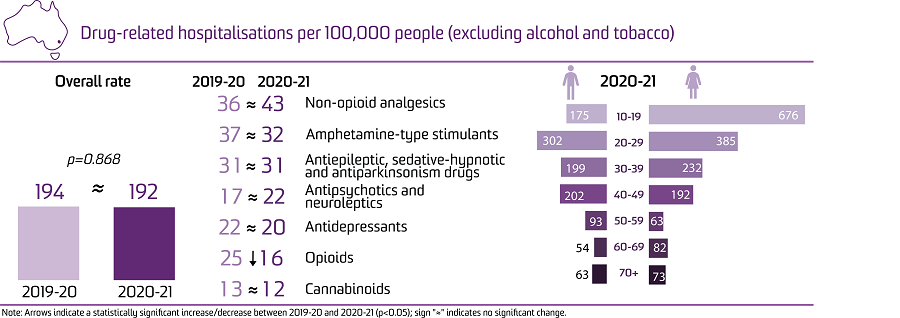
National Illicit Drug Indicators Project (NIDIP) Reports
2 November 2022
There were 875 hospitalisations with a drug-related principal diagnosis in the Australian Capital Territory in 2020-21.
This is equivalent to 192 hospitalisations per 100,000 people, which was similar to the rate in 2019-20 (194 hospitalisations per 100,000 people) and higher than the rate in 1999-00 (125 hospitalisations per 100,000 people).
Sex
The rate of hospitalisations was higher among females than males in 2020-21 (234 versus 150 hospitalisations per 100,000 people, respectively).
Age
In 2020-21, the rate of hospitalisations was highest among the 10-19 age group, followed by the 20-29 and 30-39 age groups (426, 346, and 215 hospitalisations per 100,000 people, respectively). Among males, the rate of drug-related hospitalisations was highest in the 20-29 age group, and among females in the 10-19 age group.
Remoteness Area of Usual Residence
Over 99.8% of the population in the Australian Capital Territory resided in major city areas and the remaining resided in inner regional areas. For this reason, data on hospitalisations by remoteness area are not presented.
External Cause of Drug Poisoning
Two-thirds (69%) of drug-related hospitalisations in the Australian Capital Territory were due to drug poisoning. Furthermore, 77% of drug poisoning-related hospitalisations were intentional (105 hospitalisations per 100,000 people) and 16% were unintentional (21 hospitalisations per 100,000 people).
Drug Type
In 2020-21, the rate of hospitalisations was highest where there was a principal diagnosis indicating non-opioid analgesics (43 hospitalisations per 100,000 people.
Compared to 2019-20, there was a significant decrease in the rate of hospitalisations involving opioids in 2020-21 (p=0.004).
Age-standardised rate per 100,000 people of drug-related hospitalisations, by sex, the Australian Capital Territory, 1999-00 to 2020-21.
Age-standardised rate per 100,000 people of drug-related hospitalisations, by principal diagnosis of mental and behavioural disorder due to substance use (A) and external cause of poisoning (B), the Australian Capital Territory, 1999-00 to 2020-21.
Note: Age-standardised rates were not calculated if the number of hospitalisations was less than or equal to 10 (please refer to our methods document for details). Suppressed data are visible as gaps in the data series.
Age-standardised rate per 100,000 people of drug-related hospitalisations, by drug identified in the principal diagnosis, the Australian Capital Territory, 1999-00 to 2020-21.
Note: Age-standardised rates were not calculated if the number of hospitalisations was less than or equal to 10 (please refer to our methods document for details). Suppressed data are visible as gaps in the data series.
For complete report on trends in drug-related hospitalisations in Australia please go to the national report.
Acknowledgements
Funding
The Drug Trends program is funded by the Australian Government Department of Health and Aged Care under the Drug and Alcohol Program.
Data source
We would like to acknowledge the Australian Institute of Health and Welfare for data from the National Hospital Morbidity Database.
Acknowledgements
We would like to acknowledge the contribution of those who have been involved in past reporting on drug-related hospitalisations by Drug Trends, specifically: A/Prof Timothy Dobbins, Dr Amanda Roxburgh, and A/Prof Lucinda Burns.
We thank Dr Louise Tierney and her team from the Tobacco, Alcohol and Other Drugs Unit at the Australian Institute of Health and Welfare for reviewing the report.
We acknowledge the traditional custodians of the land on which the work for this report was undertaken. We pay our respects to Elders past, present, and emerging.
Related Links
- Hospitalisations data visualisations: https://drugtrends.shinyapps.io/hospital_separations
- Hospitalisations methods document: https://ndarc.med.unsw.edu.au/resource-analytics/trends-drug-related-hos...
- For other Drug Trends publications on drug-related hospitalisations and drug-induced deaths in Australia, go to: https://ndarc.med.unsw.edu.au/project/national-illicit-drug-indicators-p...
- For more information on NDARC research, go to: http://ndarc.med.unsw.edu.au/
- For more information about the AIHW and NHMD, go to: https://www.aihw.gov.au/
- For more information on ICD coding go to: http://www.who.int/classifications/icd/en/ https://www.ihacpa.gov.au/resources/icd-10-amachiacs-eleventh-edition
- For more research from the Drug Trends program go to: https://ndarc.med.unsw.edu.au/program/drug-trends
This report was prepared by researchers from the National Drug and Alcohol Research Centre for the Drug Trends program. The Drug Trends program is coordinated by the National Drug and Alcohol Research Centre, UNSW Sydney and undertaken in partnership with the Burnet Institute, National Drug Research Institute, University of Queensland, and University of Tasmania.
This work is copyright. You may download, display, print and reproduce this material in unaltered form only (retaining this notice) for your personal, non-commercial use or use within your organisation. All other rights are reserved. Requests and enquiries concerning reproduction and rights should be addressed to NDARC, UNSW Sydney, NSW 2052, Australia.
Recommended citation: Chrzanowska, A., Man, N., Akhurst, J., Sutherland, R., Degenhardt, L. & Peacock, A. (2022). Trends in drug-related hospitalisations in Australia, 1999-2021. Sydney: National Drug and Alcohol Research Centre, UNSW Sydney. DOI: 10.26190/wrsv-3b78
Please note that as with all statistical reports there is the potential for minor revisions to data in this report. Please refer to the online version at Drug Trends.
Please contact the Drug Trends team with any queries regarding this publication: drugtrends@unsw.edu.au.

